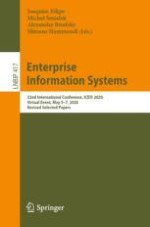2021 | Buch
Enterprise Information Systems
22nd International Conference, ICEIS 2020, Virtual Event, May 5–7, 2020, Revised Selected Papers
herausgegeben von: Prof. Dr. Joaquim Filipe, Michał Śmiałek, Alexander Brodsky, Slimane Hammoudi
Verlag: Springer International Publishing
Buchreihe : Lecture Notes in Business Information Processing
